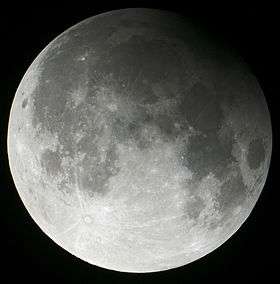June 2058 lunar eclipse

A total lunar eclipse will take place on June 6, 2058. The moon will pass through the center of the Earth's shadow.
Visibility
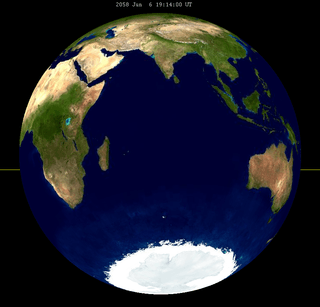
Related lunar eclipses
Lunar year series
| Descending node | Ascending node | |||||
|---|---|---|---|---|---|---|
| 111 | 2056 Jun 27 |
penumbral |
116 | 2056 Dec 22 |
penumbral | |
| 121 | 2057 Jun 17 |
partial |
126 | 2057 Dec 11 |
partial | |
| 131 | 2058 Jun 06 |
total |
136 | 2058 Nov 30 |
total | |
| 141 | 2059 May 27 |
partial |
146 | 2059 Nov 19 |
partial | |
| 156 | 2060 Nov 08 |
penumbral | ||||
Saros series
Lunar Saros series 131, has 72 lunar eclipses.
This eclipse series began in AD 1427 with a partial eclipse at the southern edge of the Earth's shadow when the Moon was close to its descending node. Each successive Saros cycle, the Moon's orbital path is shifted northward with respect to the Earth's shadow, with the first total eclipse occurring in 1950. For the following 252 years, total eclipses occur, with the central eclipse being predicted to occur in 2078. The first partial eclipse after this is predicted to occur in the year 2220, and the final partial eclipse of the series will occur in 2707. The total lifetime of the lunar Saros series 131 is 1280 years.
Because of the ⅓ fraction of days in a Saros cycle, the visibility of each eclipse will differ for an observer at a given fixed locale. For the lunar Saros series 131, the first total eclipse of 1950 had its best visibility for viewers in Eastern Europe and the Middle East because mid-eclipse was at 20:44 UT. The following eclipse in the series occurred approximately 8 hours later in the day with mid-eclipse at 4:47 UT, and was best seen from North America and South America. The third total eclipse occurred approximately 8 hours later in the day than the second eclipse with mid-eclipse at 12:43 UT, and had its best visibility for viewers in the Western Pacific, East Asia, Australia and New Zealand. This cycle of visibility repeats from the initiation to termination of the series, with minor variations.
| Greatest | First | |||
|---|---|---|---|---|
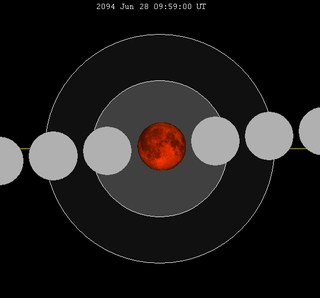 The greatest eclipse of the series will occur on 2094 Jun 28, lasting 102 minutes.[1] |
Penumbral | Partial | Total | Central |
| 1427 May 10 | 1553 July 25 | 1950 Apr 2 | 2022 May 16 | |
| Last | ||||
| Central | Total | Partial | Penumbral | |
| 2148 Jul 31 | 2202 Sep 3 | 2563 Apr 9 | 2707 Jul 7 | |
| 1914 Mar 12 | 1932 Mar 22 | 1950 Apr 2 | |||
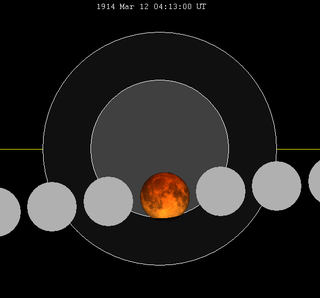 |
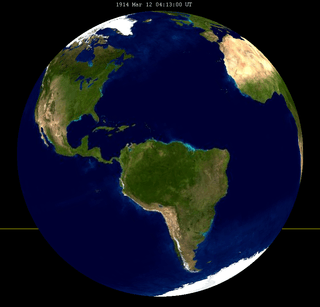 |
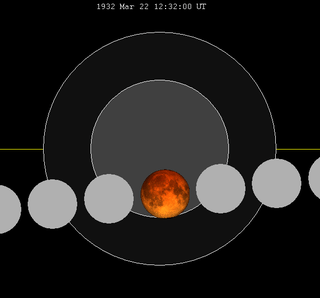 |
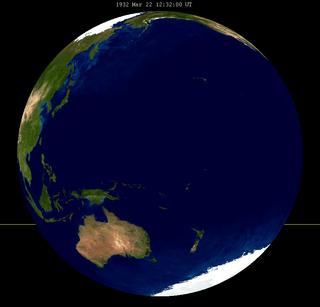 |
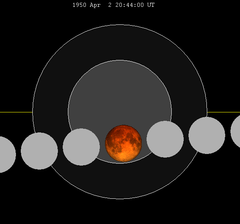 |
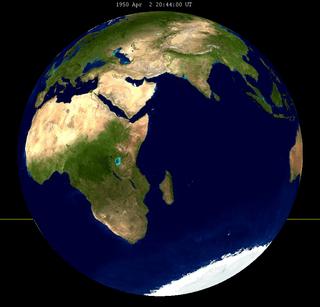 |
| 1968 Apr 13 | 1986 Apr 24 | 2004 May 4 | |||
 |
 |
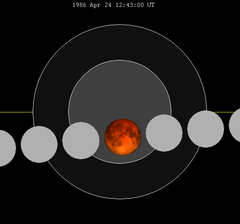 |
 |
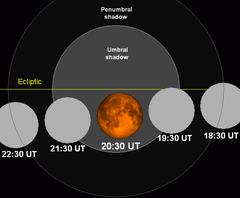 |
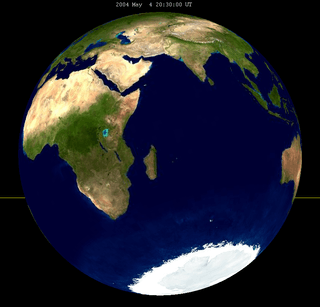 |
| 2022 May 16 | 2040 May 26 | 2058 Jun 6 | |||
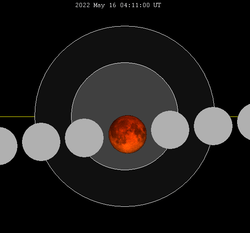 |
 |
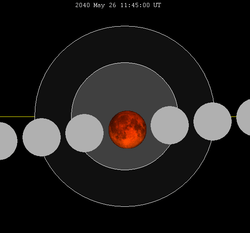 |
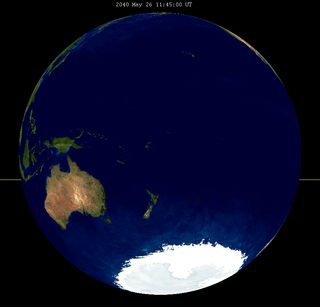 |
 |
 |
| 2076 Jun 17 | 2094 Jun 28 | ||||
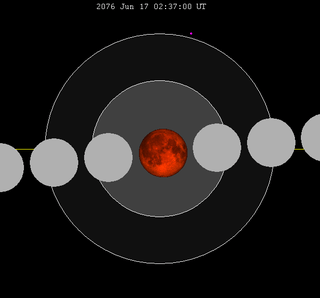 |
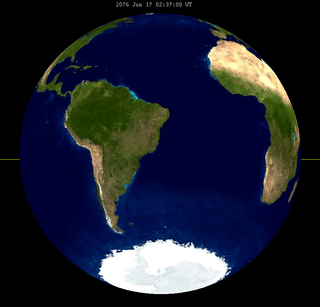 |
 |
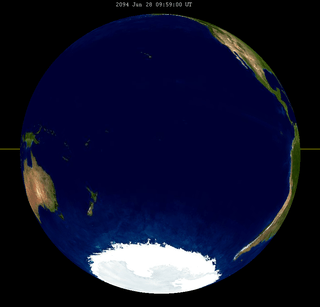 | ||
Tritos series
The tritos series repeats 31 days short of 11 years at alternating nodes. Sequential events have incremental Saros cycle indices.
This series produces 20 total eclipses between April 24, 1967 and August 1, 2167, only being partial on November 19, 2021.
| Tritos eclipse series (subset 1901–2100) | ||||||
|---|---|---|---|---|---|---|
| Descending node | Ascending node | |||||
| Saros | Date Viewing |
Type chart |
Saros | Date Viewing |
Type chart | |
| 115 | 1901 Oct 27 |
Partial |
116 | 1912 Sep 26 |
Partial | |
| 117 | 1923 Aug 26 |
Partial |
118 | 1934 Jul 26 |
Partial | |
| 119 | 1945 Jun 25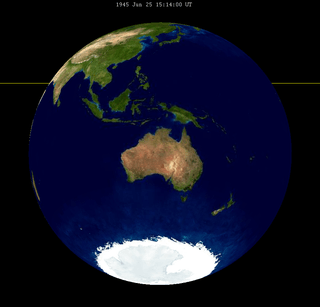 |
Partial |
120 | 1956 May 24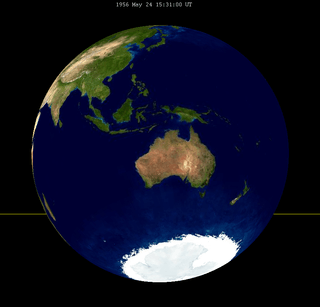 |
Partial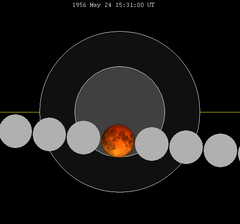 | |
| 121 | 1967 Apr 24 |
Total |
122 | 1978 Mar 24 |
Total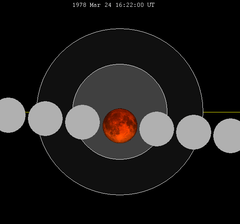 | |
| 123 | 1989 Feb 20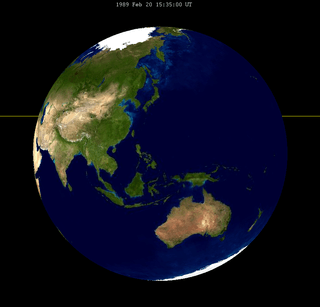 |
Total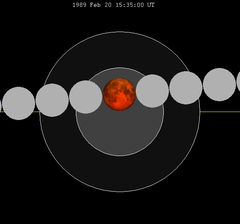 |
124 | 2000 Jan 21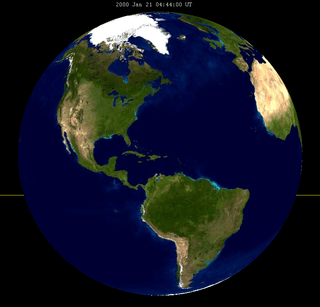 |
Total | |
| 125 | 2010 Dec 21 |
Total |
126 | 2021 Nov 19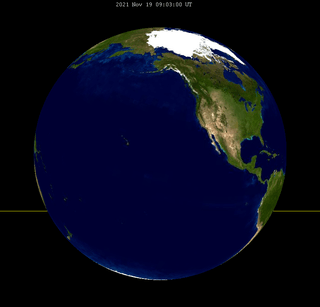 |
Partial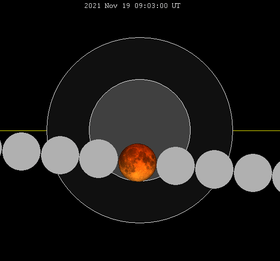 | |
| 127 | 2032 Oct 18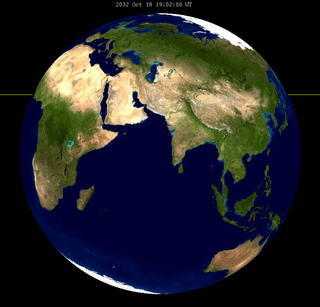 |
Total |
128 | 2043 Sep 19 |
Total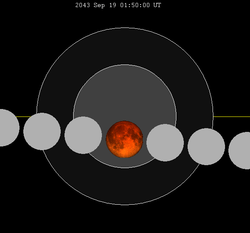 | |
| 129 | 2058 Jun 6 |
Total |
130 | 2069 May 6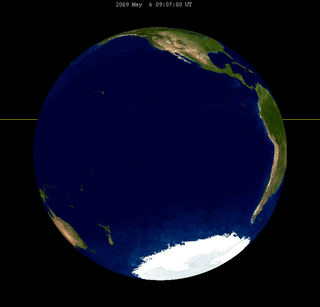 |
Total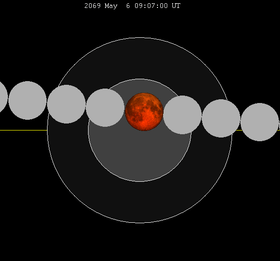 | |
| 131 | 2080 Apr 4 |
Total |
132 | 2091 Mar 5 |
Total | |
Inex series
The inex series repeats eclipses 20 days short of 29 years, repeating on average every 10571.95 days. This period is equal to 358 lunations (synodic months) and 388.5 draconic months. Saros series increment by one on successive Inex events and repeat at alternate ascending and descending lunar nodes.
This period is 383.6734 anomalistic months (the period of the Moon's elliptical orbital precession). Despite the average 0.05 time-of-day shift between subsequent events, the variation of the Moon in its elliptical orbit at each event causes the actual eclipse time to vary significantly.
All events in this series shown (from 1000 to 2500 and beyond) are central total lunar eclipses.
| Descending node | Ascending node | Descending node | Ascending node | ||||
|---|---|---|---|---|---|---|---|
| Saros | Date | Saros | Date | Saros | Date | Saros | Date |
| 95 | 1016 May 24 | 96 | 1045 May 3 | 97 | 1074 Apr 14 | 98 | 1103 Mar 25 |
| 99 | 1132 Mar 3 | 100 | 1161 Feb 12 | 101 | 1190 Jan 23 | 102 | 1219 Jan 2 |
| 103 | 1247 Dec 13 | 104 | 1276 Nov 23 | 105 | 1305 Nov 2 | 106 | 1334 Oct 13 |
| 107 | 1363 Sep 23 | 108 | 1392 Sep 2 | 109 | 1421 Aug 13 | 110 | 1450 Jul 24 |
| 111 | 1479 Jul 4 | 112 | 1508 Jun 13 |
113 | 1537 May 24 | 114 | 1566 May 4 |
| 115 | 1595 Apr 24 | 116 | 1624 Apr 3 | 117 | 1653 Mar 14 | 118 | 1682 Feb 21 |
| 119 | 1711 Feb 3 | 120 | 1740 Jan 13 | 121 | 1768 Dec 23 | 122 | 1797 Dec 4 |
| 123 | 1826 Nov 14 | 124 | 1855 Oct 25 | 125 | 1884 Oct 4 | 126 | 1913 Sep 15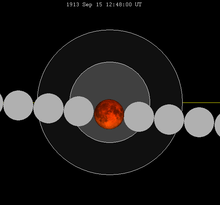 |
| 127 | 1942 Aug 26 |
128 | 1971 Aug 6 |
129 | 2000 Jul 16 |
130 | 2029 Jun 26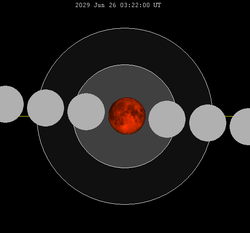 |
| 131 | 2058 Jun 6 |
132 | 2087 May 17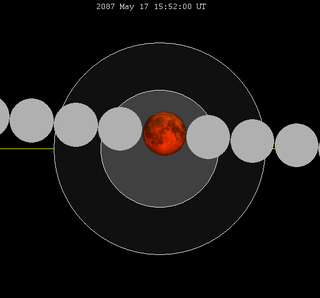 |
133 | 2116 Apr 27 | 134 | 2145 Apr 7 |
| 135 | 2174 Mar 18 | 136 | 2203 Feb 26 | 137 | 2232 Feb 7 | 138 | 2261 Jan 17 |
| 139 | 2289 Dec 27 | 140 | 2318 Dec 9 | 141 | 2347 Nov 19 | 142 | 2376 Oct 28 |
| 143 | 2405 Oct 8 | 144 | 2434 Sep 18 | 145 | 2463 Aug 29 | 146 | 2492 Aug 8 |
See also
Notes
External links
| Wikimedia Commons has media related to Lunar eclipse of 2056 Jun 6. |
- 2058 Jun 06 chart Eclipse Predictions by Fred Espenak, NASA/GSFC
